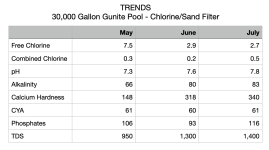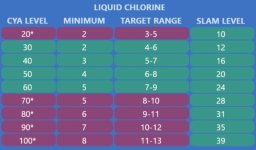Since opening in May, the chlorine pool has remained clear and mostly a TFP thanks to the advice from this group, use of Taylor K-2006C and poolmath.
The chemical requirements have been mostly +2gal Liquid Chlorine about every week, with pH/Alkalinity/Hardness moving in and out of range when it rains, or having to add 500gallons of city water to counter evaporation (have a flow meter attached to hose), so I am letting them fluctuate instead of actively treating it with chemicals to reach a target level. I also add 3 tricolor tablets to the floater about every 2 weeks.
I often get the water tested at Leslies pool to have a read on Copper (0.5), Phosphates (116) and TDC (1400) (7/18/2023 values), however I follow the Taylor K-2006 and pool math app for any action.
Why this post? While the pool remains clear, I have noticed a slow increase in Phosphates and TDS and seeking advice if there is any indicated action to take.
Additional observations:
a) Prior owners did a poor job painting the gunite pool white, as the paint keeps flacking off every time the Dolphin Explorer E70 robot cleaner is used
b) Overnight test shows no Chlorine loss
c) The submerged walls, while no visible off-color, feel slick to touch, so I have began to brush the sides and floor with a pole/brush. Occasionally I noticed white clouds being formed when brushing the floor, suggesting some sort of floor deposit. (LIKELY THE SOURCE OF INCREASED TDS)
d) Backwashing every 2-3 weeks does not show much visible cloudiness
e) New variable speed pump running 2,900rpm 24/7 (have not tested variable speeds yet)

The chemical requirements have been mostly +2gal Liquid Chlorine about every week, with pH/Alkalinity/Hardness moving in and out of range when it rains, or having to add 500gallons of city water to counter evaporation (have a flow meter attached to hose), so I am letting them fluctuate instead of actively treating it with chemicals to reach a target level. I also add 3 tricolor tablets to the floater about every 2 weeks.
I often get the water tested at Leslies pool to have a read on Copper (0.5), Phosphates (116) and TDC (1400) (7/18/2023 values), however I follow the Taylor K-2006 and pool math app for any action.
Why this post? While the pool remains clear, I have noticed a slow increase in Phosphates and TDS and seeking advice if there is any indicated action to take.
Additional observations:
a) Prior owners did a poor job painting the gunite pool white, as the paint keeps flacking off every time the Dolphin Explorer E70 robot cleaner is used
b) Overnight test shows no Chlorine loss
c) The submerged walls, while no visible off-color, feel slick to touch, so I have began to brush the sides and floor with a pole/brush. Occasionally I noticed white clouds being formed when brushing the floor, suggesting some sort of floor deposit. (LIKELY THE SOURCE OF INCREASED TDS)
d) Backwashing every 2-3 weeks does not show much visible cloudiness
e) New variable speed pump running 2,900rpm 24/7 (have not tested variable speeds yet)



